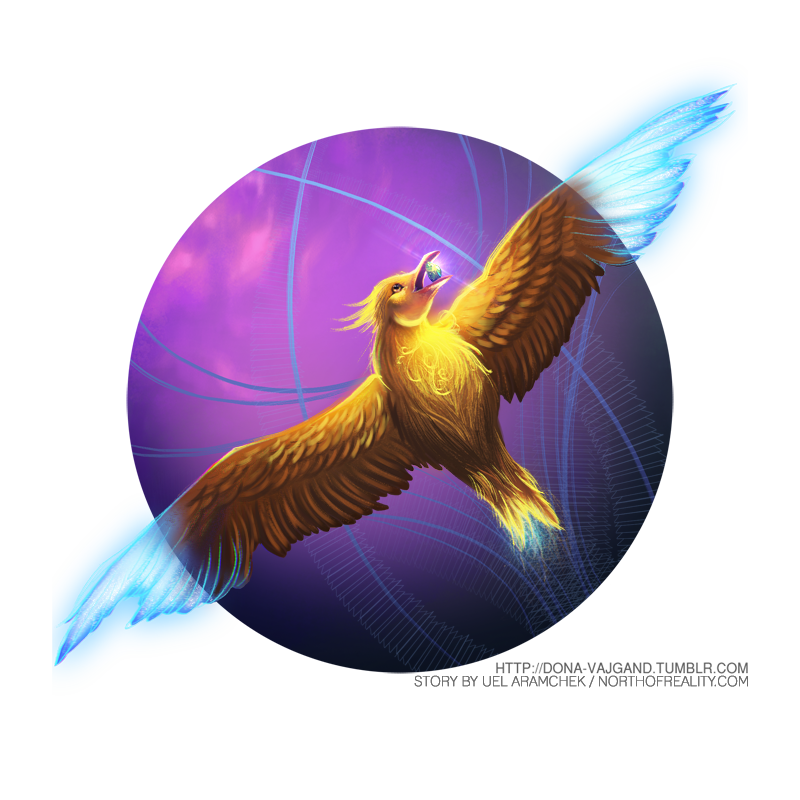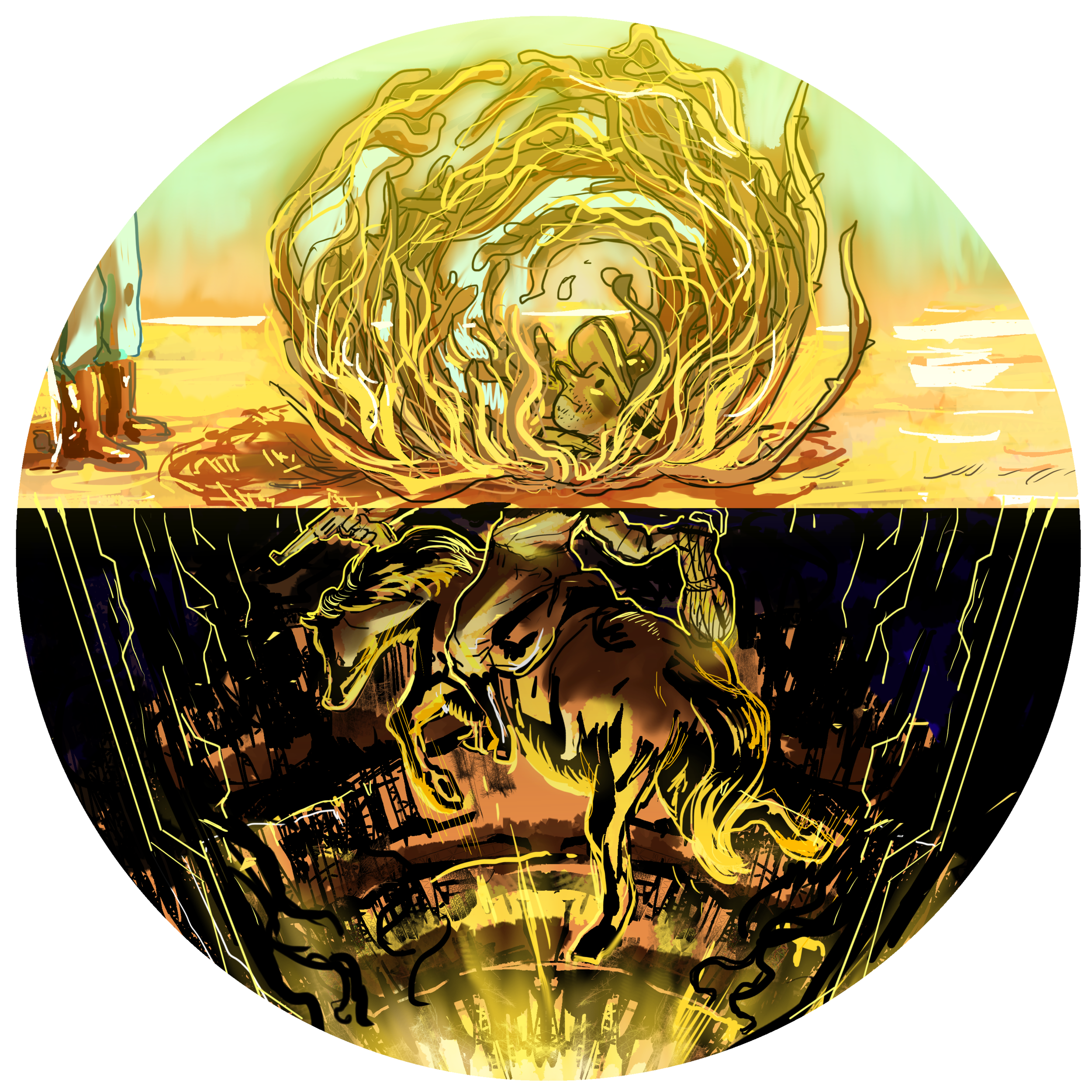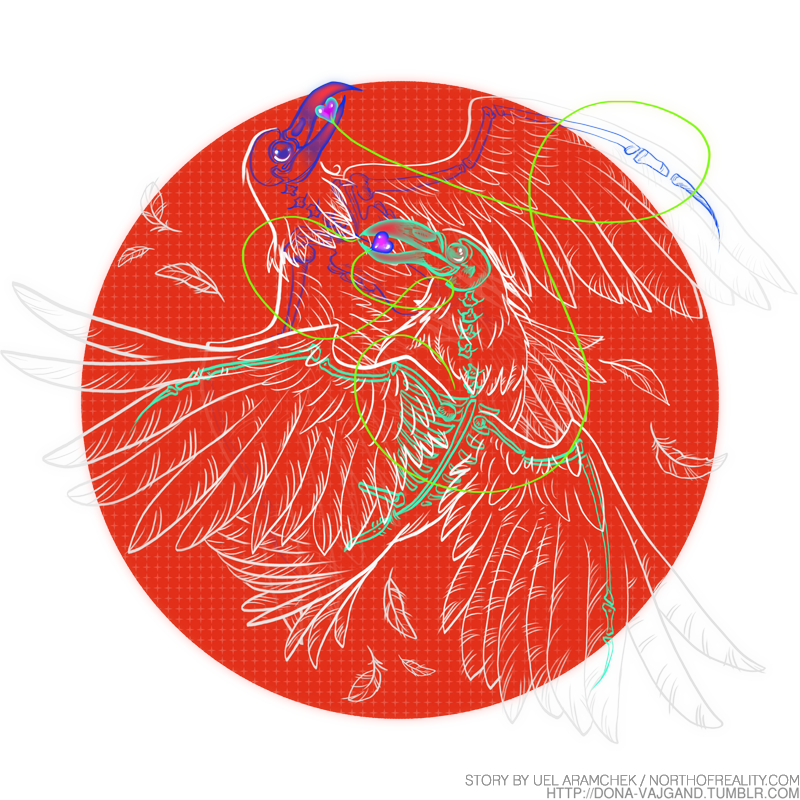Shortly after the arrival of the twentieth century, natural selection replaced the homing pigeon with the radio wave. This evolutionary leap resulted in the emergence of electrobiology as an academic field. Other members of the animal kingdom underwent a similar metamorphosis, though there is little agreement about what became of the barber’s hummingbird.
Before its disappearance, this avian was the largest of the trochilidae family, weighing between four and five kilograms, and possessing a long, slender beak which could exceed ten inches in length. Its insidious name referred as much to the medieval meaning of "barber" as it did the modern; its beak, which it would sharpen against stones in its subterranean nest, was used to slide through the sagittal sutures present in the skulls of most fauna, allowing it to burrow harmlessly into the space between their brain lobes.
Though this intrusion left behind a small wound and uneasy dreams, the hummingbird didn’t actually drink any of the humors of other animals. Despite rumors of vampirism, it maintained its metabolism by boring into trees for their sap, which provided enough fuel to support its helicopter-like locomotion. Its interaction with the brain is believed to have been some form of primordial interface, whereby the bird could obtain sensory information from the neurons of other lifeforms to chart its own migration. However, this had the consequence of cross-pollinating memories between affected animals, as well as between people, often causing their thoughts to align with the wrong places and identities.
This cross-pollination was briefly weaponized during the first world war, where barber's hummingbirds were loosed upon the battlefield by the Austro-Hungarian army. This allowed soldiers to dream the memories of their adversaries, revealing plans and weaknesses abound. The enforced transparency went both ways, however, and the tactic revealed much more than merely enemy secrets. As a result, what began as proliferation ended in extermination, and many of their beaks were repurposed as bayonets.
The Great War is traditionally believed to have been an extinction-level event for the barber’s hummingbird, as the species hasn’t been seen in the wild ever since. Even so, as scholars like Jung and Persinger have noted, the cross-pollination of memories in dreams has continued well beyond this point. To account for this, electrobiological researchers have proposed that, in a similar manner to the homing pigeon’s metamorphosis, the barber’s hummingbird is the common ancestor of our very own brain waves.
The barber's hummingbird could gain knowledge from other animals, but not wisdom.
As of yet, there is very little scholarship on hummingbird-squid symbiosis.
There is a commonly circulated urban legend concerning earwigs that their name is a reference to a particularly horrifying type of parasitism: that they propagate by burrowing into the human cranium through the ear canal, then tunnel their way into the brain’s gray matter where they lay their eggs.
In modernity, most discover this myth by encountering a statement of its negation. Nearly every text concerning earwigs includes, somewhere in the first few sentences, language similar to this: “Despite their nomenclature, earwigs do not actually propagate by burrowing into the human cranium through the ear canal to lay their eggs, though this is a commonly circulated urban legend.”
The antlion is unique among modern animalia in that its evolution resulted not from a mutation within its genetic code, but rather, within the spelling of its name. Sometime during the legendary translation of the Septuagint from Hebrew into Greek for Ptolemy II, an old Hebrew variant of 'lion' used in the Book of Job was warped into the bizarre word 'myrmecoleon,' a portmanteau of the terms for 'ant' and 'lion.'
Shortly after the arrival of the twentieth century, natural selection replaced the homing pigeon with the radio wave. This evolutionary leap resulted in the emergence of electrobiology as an academic field. Other members of the animal kingdom underwent a similar metamorphosis, though there is little agreement about what became of the barber’s hummingbird.
In his bestiary’s entry regarding tigers, Leonardo da Vinci describes a bizarre interaction between humans and these mighty beasts:
"This is a native of Hyrcania; it bears some resemblance to the panther from the various spots on its skin; and it is an animal of terrifying speed. When the hunter finds its cubs he carries them off instantly, after placing mirrors at the spot from which he has taken them, and immediately takes to flight upon a swift horse."
In the year 1968, there were four separate cases of submarines disappearing under mysterious circumstances: the American Scorpion, the Israeli Dakar, the French Minerve, and the Soviet K-129. The last of these events came under scrutiny when, six years later, a United States black project disguised as a manganese mining operation attempted to locate and salvage what was left of the Soviet submarine. This program was known as “Project Azorian,” and was primarily carried out by a single vessel known as The Glomar Explorer.
Among believers, vaultgulls are said to possess golden feathers, as well as eyes of black crystal; then again, they are also said to have never before been seen, so such descriptions ought to be met with skepticism.
For these clever birds, all that is unseen is the sky; their wings slide cleanly through metal and stone as easily the wind. The only solid surface they know is the periphery of human vision, the greatest obstacle to their shimmering wings. The subtlest twitch of a single eye is enough to thrust them aside like a hurricane's gales.
Wild trumpets must be dried out before they can be safely played by a human mouth. The local tribes of Hyperborea's easternmost islands have mastered this process: they hang the bulbous creatures over a pyre of burning inkwood, whose smoke drains their bells of any lingering venom and stains their skins an obsidian shade. The instrument that results has a limited range, yet this is counterbalanced by its powerful timbre.
When confronted with the possibility of being devoured, the common gecko is capable of making a somewhat brutal compromise [...] the lizard can shed the entirety of its own tail as an offering to potential predators. During such a transaction, the predator receives a much smaller meal, but the gecko’s life is spared, and its tail eventually grows back.
Eighteenth century explorer José de Almagro claimed to have discovered a much more curious specimen in the mountains of what is today Chile: a gecko which, when threatened, could shed its entire body at once.
Another tumbleweed rolled into town yesterday- the third of its kind this month. This time around, the professor’s trap finally worked: we found the damn thing snagged in a tangle of barbed wire, screeching loudly, trying in vain to unfurl its hungry tendrils. This one was at least thirty feet in diameter, so we figured that something good had to be buried under all those thorns.
The hollowfeather crow curls its neck inward. It then reaches its beak through its own chest, plucks out a pulseless heart, and devours it whole once more. Once it has been swallowed, the extracted organ can be seen from outside as it tumbles downward through exposed, translucent ribs, and eventually snaps back into position. The crow does this again and again, restlessly staving off its own endless hunger.
The author remained perfectly still as the tarantula wandered across his typewriter’s keys. With eight grotesque legs, it spelled out the secret name of death, and he recognized it as soon as it appeared. It was the sort of name that could only be pronounced with one’s final gasp; as such, he didn’t dare utter it, for fear that it’s owner might come forth upon hearing his voice.
Thricelings are born incomplete. They emerge from the womb not as living things, but instead, as motionless, beige mounds with the consistency of bread dough. These formless masses rest on porcelain slabs in nurseries, warmed and nourished by the heat of the fires beneath them. Should they survive this process for two weeks without melting or crumbling, they will be considered viable, and allowed to progress to their second birth.
Gremlins are known to live in the engines of airplanes, the spindles of hard drives, and the pipes of boiler rooms. No space within human industry has ever proven hostile enough to prevent their occupation, making them some of the hardiest lifeforms on this planet. Furthermore, they are notoriously difficult to capture, or even to spot; their presence is only ever known in hindsight, evidenced by chewed-through wires, rust-addled screws, and corrupted data.
It is a difficult matter for squid to survive without access to a body of water. Only one species is known to do so at length: Oneiroteuthis demiurgis, a symbiont otherwise known as the dreamer squid. When found in nature, it bears little resemblance to its ocean-bound cousins. Its gray tentacles remain tightly curled around its mantle at all times, causing it to appear as little more than a labyrinthine mound of wrinkles. It spends the majority of its lifespan in total stillness, dreaming about a surrounding world that it never sees with its own eyes.
“At first, we thought that our fortunes had changed,” his journal begins. “We saw what we thought was a whale breaching when a jet of vapor erupted from the waters along our ship’s port side. As we readied our harpoons, however, we found that the geyser seemed to have no source but the surface of the ocean itself. One of the other sailors exclaimed that it must have been a ‘mirror whale,’ meaning that both sides of its blowhole were on the outside of its body. As such, there was nothing for us to see or kill.”
Towards the end of the twentieth century, several gigantic teeth were found mellified in a pit of ancient lobster honey. A team of paleontologists cleaned away the sea-green ooze, which, by their account, had gone undisturbed for at least five-hundred thousand years. Initial reports suggested that they belonged to an unknown creature which died while attempting to swallow an entire lobster hive at once.
Just before it reaches the state of the same name, the Mississippi splits in two- one river above, and one river below. The old waterway’s underground sister diverges into numerous caverns, most of which prove to be dead ends. One of these branches spirals downward for almost a mile, however, into a vast, subterranean kingdom where the borders of the nations above have no meaning.
The body of a sea serpent is most often seen as a sine wave. As it propels itself across the water, its length protrudes from the ocean as a series of archways between the tail and the head. When humans attempt to observe the creature from beneath the water, however, they discover that there’s nothing at all to be seen. For this reason, many have written off the mysterious beast’s existence altogether; despite the profound number of sightings over time, no physical specimen has ever been recovered.
Wishing wells have a metabolism which is much like that of pitcher plants. Coins cast into their bowels are digested over the course of several decades, and are eventually left faceless and without luster. The pit then excretes a perfume of willpower into the atmosphere, resulting in subtle shifts in the ways of the world.
Two nearly identical fossils await in a cold room beneath the museum, in an exhibit long forgotten. Each slab of stone contains the imprint of some six-winged avian with a long, barbed tail, and no head. Both are longer than any human has ever been tall.
Beneath the glass display is a plaque, which reads as follows:
A young prince arrives at the ruins of Las Vegas with an elephant gun in his hands. The new Sphinx is waiting for him at the gates, unsurprised by his arrival, although perhaps a bit amused. Her hydraulics begin groaning loudly. She rises onto all four paws, and her fiber optic mane glimmers to life with rings of artificial color. Then, she speaks. “Coloradan Royalty, out here? To what do I owe the pleasure?”
The gnomes of Hyperborea are neither born nor created; they enter our world by climbing out of their own shadows, and leave a few hours later when they inevitably tumble back down into them. At the bottom of each of these peculiar holes (sometimes over thirty miles in depth) is a pool of black lava of unknown origin. Some say that each such shadow is a window into a second underground, and that our planet hides multiple interiors beneath a single surface. Others claim that there is no such multitude of underworlds, and that the gnomes create a material debt by existing that eventually swallows their borrowed bodies whole.
You’ve come to this forest in search of the creature known as "sasquatch." By now you’ve learned that he is human; at least, by some definitions of the word "human." His flesh has been warped by years of long-exposure photographs, and his skin has blurred into a pareidoliac wool. A grotesque thumbprint remains where once there may have been a face, neither able to see nor speak.
The first tooth appeared while you were combing your hair in the bathroom. It was clearly outlined in your peripheral vision, and so close that your eyelids began to twitch from reflex- yet there was nothing to be seen in the mirror at all. You tried unplugging the mirror and plugging it back in again, but the teeth refused to appear to anyone except yourself. Over the course of the next month, they began increasing in number- you swore that you could feel several under your own skin.





